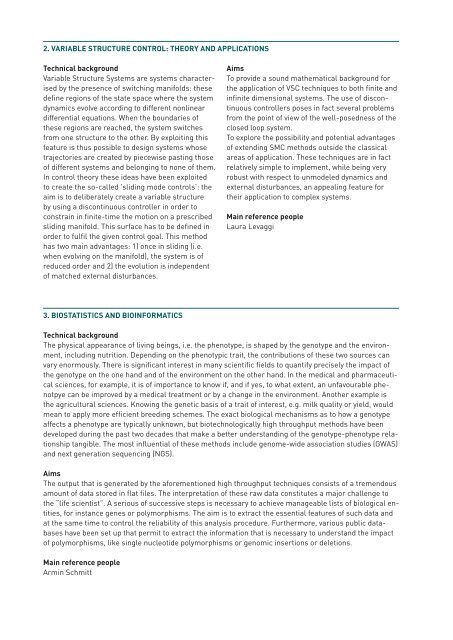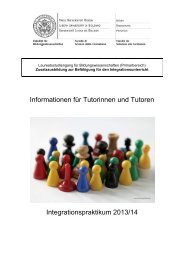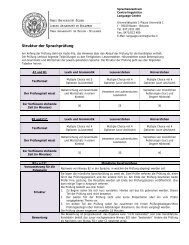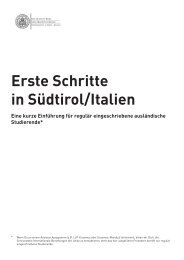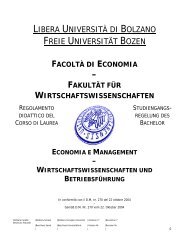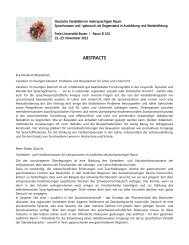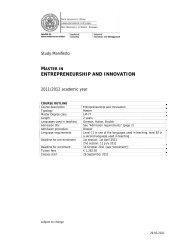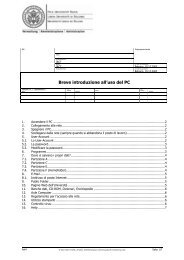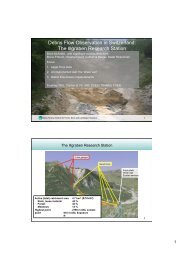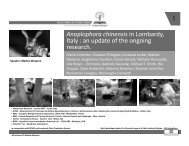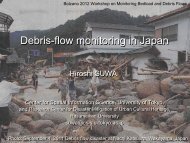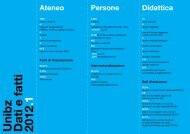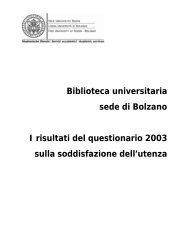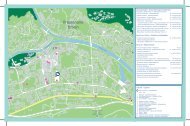Activity report - Free University of Bozen · Bolzano
Activity report - Free University of Bozen · Bolzano
Activity report - Free University of Bozen · Bolzano
You also want an ePaper? Increase the reach of your titles
YUMPU automatically turns print PDFs into web optimized ePapers that Google loves.
2. Variable structure control: theory and applications<br />
Technical background<br />
Variable Structure Systems are systems characterised<br />
by the presence <strong>of</strong> switching manifolds: these<br />
define regions <strong>of</strong> the state space where the system<br />
dynamics evolve according to different nonlinear<br />
differential equations. When the boundaries <strong>of</strong><br />
these regions are reached, the system switches<br />
from one structure to the other. By exploiting this<br />
feature is thus possible to design systems whose<br />
trajectories are created by piecewise pasting those<br />
<strong>of</strong> different systems and belonging to none <strong>of</strong> them.<br />
In control theory these ideas have been exploited<br />
to create the so-called 'sliding mode controls': the<br />
aim is to deliberately create a variable structure<br />
by using a discontinuous controller in order to<br />
constrain in finite-time the motion on a prescribed<br />
sliding manifold. This surface has to be defined in<br />
order to fulfil the given control goal. This method<br />
has two main advantages: 1) once in sliding (i.e.<br />
when evolving on the manifold), the system is <strong>of</strong><br />
reduced order and 2) the evolution is independent<br />
<strong>of</strong> matched external disturbances.<br />
Aims<br />
To provide a sound mathematical background for<br />
the application <strong>of</strong> VSC techniques to both finite and<br />
infinite dimensional systems. The use <strong>of</strong> discontinuous<br />
controllers poses in fact several problems<br />
from the point <strong>of</strong> view <strong>of</strong> the well-posedness <strong>of</strong> the<br />
closed loop system.<br />
To explore the possibility and potential advantages<br />
<strong>of</strong> extending SMC methods outside the classical<br />
areas <strong>of</strong> application. These techniques are in fact<br />
relatively simple to implement, while being very<br />
robust with respect to unmodeled dynamics and<br />
external disturbances, an appealing feature for<br />
their application to complex systems.<br />
Main reference people<br />
Laura Levaggi<br />
3. Biostatistics and bioinformatics<br />
Technical background<br />
The physical appearance <strong>of</strong> living beings, i.e. the phenotype, is shaped by the genotype and the environment,<br />
including nutrition. Depending on the phenotypic trait, the contributions <strong>of</strong> these two sources can<br />
vary enormously. There is significant interest in many scientific fields to quantify precisely the impact <strong>of</strong><br />
the genotype on the one hand and <strong>of</strong> the environment on the other hand. In the medical and pharmaceutical<br />
sciences, for example, it is <strong>of</strong> importance to know if, and if yes, to what extent, an unfavourable phenotpye<br />
can be improved by a medical treatment or by a change in the environment. Another example is<br />
the agricultural sciences. Knowing the genetic basis <strong>of</strong> a trait <strong>of</strong> interest, e.g. milk quality or yield, would<br />
mean to apply more efficient breeding schemes. The exact biological mechanisms as to how a genotype<br />
affects a phenotype are typically unknown, but biotechnologically high throughput methods have been<br />
developed during the past two decades that make a better understanding <strong>of</strong> the genotype-phenotype relationship<br />
tangible. The most influential <strong>of</strong> these methods include genome-wide association studies (GWAS)<br />
and next generation sequencing (NGS).<br />
Aims<br />
The output that is generated by the aforementioned high throughput techniques consists <strong>of</strong> a tremendous<br />
amount <strong>of</strong> data stored in flat files. The interpretation <strong>of</strong> these raw data constitutes a major challenge to<br />
the “life scientist”. A serious <strong>of</strong> successive steps is necessary to achieve manageable lists <strong>of</strong> biological entities,<br />
for instance genes or polymorphisms. The aim is to extract the essential features <strong>of</strong> such data and<br />
at the same time to control the reliability <strong>of</strong> this analysis procedure. Furthermore, various public databases<br />
have been set up that permit to extract the information that is necessary to understand the impact<br />
<strong>of</strong> polymorphisms, like single nucleotide polymorphisms or genomic insertions or deletions.<br />
Main reference people<br />
Armin Schmitt


